#electronics and communication engineering course
Explore tagged Tumblr posts
Text




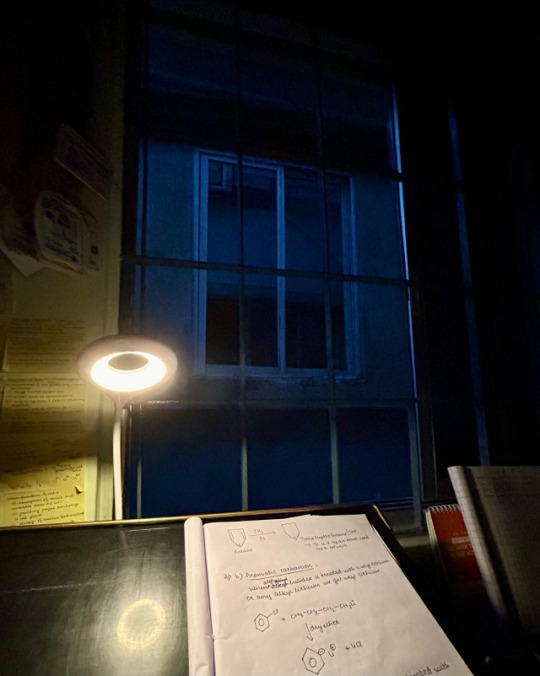
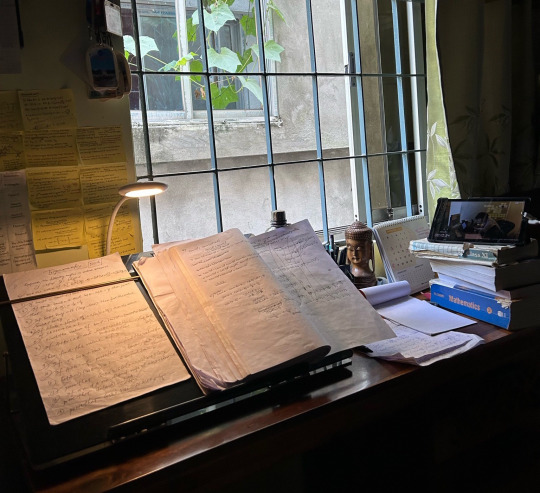
And with this, high school comes to an end…
22.06.25, Sunday:
THANK YOU SOOO MUCH TO THIS WONDERFUL COMMUNITY FOR HELPING ME RISE FROM ALL HURDLES AND ACHIEVE MY DREAMS <3. I have been provisionally admitted to an Engineering College and I am so excited!!! I’ll start studying for my Bachelor of Technology (B.Tech) degree from August. Currently I have been admitted for the Electrical Engineering degree but I want to go further and pursue the Electronics and Communications Engineering degree. So, I am waiting for it a bit. But the good news is most engineering degrees have the same course in first year. So, to stay ahead (and because I am bored) I will be starting 100 day study challenge from tomorrow (23.06.25).
A new journey begins!!

#stem academia#studyblr#academia#student life#academia aesthetic#classic academia#dark academia#light academia#chaotic academia#grey academia#college#college life#studyspiration#studystudystudy#study motivation#study blog#study inspiration
20 notes
·
View notes
Text
B Tech In Electronics And Communication Engineering
Get the best b tech in electronics and communication engineering courses from Swami Vivekananda University in Kolkata. We provide comprehensive course with placement.

#b tech in electronics and communication engineering#b tech ece colleges#bachelor of science in electronics and communications engineering#btech electronics and communication#b tech electronics and communication syllabus#electronics and communication engineering course#best college for electronics and communication engineering#b tech electronics and telecommunication syllabus#electronics and communication engineering courses in kolkata#b tech in electronics and communication courses
0 notes
Text

Get The Best Diploma in Electronics and Telecommunication Engineering in 2023
Are you looking for the best electronics training courses from the best electronic and telecommunication engineering institute in Kolkata? then visit George Telegraph today and know your course fees details. We provide 100% job placement assistance. Join Now.
#diploma in electronics and telecommunication engineering#electronics and telecommunication engineering#electronics and communication engineering course#george telegraph course#telecommunication courses#electronics training courses#electronics course#electronics courses#courses for electronics engineer#telecommunication engineering courses#electrical and telecommunication engineering#electronics training course#electronic and telecommunication engineering
0 notes
Text
B.Tech in Electronics Engineering: Courses, Careers & Future Scope Explained
In today’s hyper-connected world where technology evolves faster than we can keep up, one engineering discipline remains at the core of it all—Electronics Engineering. From smartphones and satellite systems to electric vehicles and smart cities, the fingerprints of electronics engineers are everywhere.
A B.Tech in Electronics Engineering is not just another undergraduate degree. It’s a gateway to a future shaped by innovation, automation, and global impact.
Whether you’re a student planning your engineering path, a parent looking for clarity, or a professional exploring career pivots, this comprehensive guide will walk you through the course structure, career scope, top recruiters, and global opportunities available with a B.Tech in Electronics Engineering.
What is B.Tech in Electronics Engineering?
B.Tech in Electronics Engineering is a four-year undergraduate program that focuses on the principles and applications of electronics, electromagnetism, circuit design, communication systems, embedded systems, and signal processing.
It merges theoretical knowledge with practical lab-based learning, preparing students for diverse industries such as telecommunications, defense, manufacturing, IT, healthcare, and research.
🎓 Explore more academic insights and counseling services at Edunet Educare
Why Choose Electronics Engineering?
Ubiquity of Electronics: Everything from your TV to Tesla runs on electronics.
Diverse Career Options: Graduates can work in design, development, production, testing, or even sales and consultancy.
R&D Opportunities: With AI, robotics, and IoT booming, R&D roles are plentiful.
Government & Public Sector Jobs: A wide range of jobs await in ISRO, DRDO, BEL, and more.
International Relevance: The skills learned are transferable globally.
In short, it's a future-proof degree in a digitally driven world.
Eligibility Criteria
To enroll in a B.Tech in Electronics Engineering program in India, aspirants typically need:
Completion of Class 12 with Physics, Chemistry, and Mathematics (PCM)
A qualifying score in entrance exams such as:
JEE Main / Advanced
State-level entrance tests (MHT CET, KCET, WBJEE, etc.)
Private university exams (VITEEE, SRMJEEE, etc.)
Core Subjects You’ll Study
Here’s a snapshot of some foundational and advanced subjects included in the Electronics Engineering curriculum:
📘 First Year:
Engineering Mathematics
Engineering Physics/Chemistry
Basics of Electrical & Electronics Engineering
Programming in C/C++
Engineering Graphics
⚙️ Second Year:
Analog & Digital Electronics
Network Theory
Signals and Systems
Data Structures
Electronic Devices and Circuits
📡 Third Year:
Microprocessors and Microcontrollers
Control Systems
Communication Engineering
Embedded Systems
VLSI Design
🔧 Final Year:
Industrial Training / Internship
Major Project
Electives (like Robotics, IoT, AI in Electronics)
Laboratory work, mini-projects, seminars, and workshops play a huge role in enhancing real-world skills.
Top Colleges Offering B.Tech in Electronics Engineering (India)
IITs (Delhi, Bombay, Kharagpur, etc.)
NITs (Trichy, Surathkal, Warangal, etc.)
BITS Pilani
Delhi Technological University (DTU)
VIT Vellore
SRM Institute of Science and Technology
Each institution has its own admission procedure, faculty expertise, placement track record, and industry tie-ups.
Career Opportunities After B.Tech in Electronics Engineering
The career landscape for electronics engineers is vast and continues to evolve with technological advancements. Some key career paths include:
🖥️ Design & Development Engineer
Work with product teams to design consumer electronics, industrial machines, or automotive components.
📶 Communication Engineer
Join telecom giants like Airtel, Jio, or Vodafone to develop and maintain communication networks.
⚙️ Embedded Systems Engineer
Program microcontrollers and design embedded solutions for appliances, vehicles, and robots.
🛰️ Satellite & Aerospace Engineer
Work in space research, satellite design, and mission planning at ISRO or private space tech firms.
💻 Software Developer (Electronics-based)
Many electronics engineers transition into software development, especially in hardware-software integrated projects.
🏢 PSU/Government Jobs
Crack GATE or other exams to work with DRDO, ISRO, BHEL, ECIL, or Indian Railways.
🌍 International Jobs
With relevant certifications and experience, engineers can work in the US, Germany, Japan, and other tech-heavy nations.
💼 Curious about career counseling or course selection? Visit Edunet Educare for personalized guidance.
Higher Studies & Certifications
Electronics Engineering opens doors to prestigious postgraduate paths:
M.Tech / MS in Electronics & Communication / VLSI / Embedded Systems
MBA in Technology Management or Operations
Certifications in:
Embedded Systems (ARM, STM32)
IoT and AI (Coursera, edX)
MATLAB & Simulink
PCB Design and Circuit Simulation
Top Recruiters in Electronics Engineering
India’s growing electronics and semiconductor ecosystem has led to booming demand. Here are some top recruiters:
Intel
Texas Instruments
Qualcomm
Samsung R&D
TCS
Wipro
Infosys
ISRO
DRDO
L&T
BEL
Reliance Jio
Nokia
CISCO
Job roles vary from VLSI designers to testing engineers, field application engineers, and hardware developers.
Skills That Set You Apart
To thrive in the electronics field, complement your academic degree with the following:
Proficiency in programming (C/C++, Python, Verilog)
Knowledge of PCB designing tools like Eagle or Altium
Understanding of communication protocols (UART, SPI, I2C)
Problem-solving and logical thinking
Ability to read datasheets and design technical documentation
Future Scope & Emerging Trends
The landscape of electronics engineering is transforming rapidly. New-age domains gaining traction include:
Internet of Things (IoT)
Artificial Intelligence & Machine Learning in Hardware
Smart Grids & Renewable Energy Systems
Electric Vehicle Design
VLSI & Semiconductor Manufacturing
Autonomous Systems & Robotics
With India investing heavily in indigenous chip-making and global tech giants expanding operations, electronics engineers are in higher demand than ever before.
Conclusion: A Degree That Powers Innovation
A B.Tech in Electronics Engineering isn’t just about learning circuits and codes. It’s about being at the frontline of technological revolution—designing solutions that improve lives, create smarter cities, and push boundaries in space, healthcare, and industry.
If you're passionate about electronics, love solving problems, and dream of a career that combines creativity with cutting-edge tech, this is your calling.
🌐 Ready to explore the world of electronics engineering? Get expert counseling and curated content at Edunet Educare
#B.Tech in Electronics Engineering#Electronics and Communication#Engineering Courses India#Careers in Electronics#Top Engineering Branches#Edunet Educare#Electronics Career Scope#GATE Exam#Embedded Systems#IoT in Engineering#Best Colleges for B.Tech#PCB Design#VLSI Engineering#Jobs for Electronics Engineers#Electronics Government Jobs#Tech Education India#STEM Courses#Engineering Admissions#Career Counseling India#Future of Electronics
0 notes
Text
Woxsen University is recognized as one of the top B.Tech colleges in India, offering cutting-edge programs in engineering and technology. Its B.Tech curriculum is designed to equip students with technical expertise and problem-solving skills through a blend of theoretical knowledge and practical application. Woxsen provides specializations in Artificial Intelligence, Data Science, and other emerging fields, ensuring that graduates are industry-ready. The university’s state-of-the-art labs, experienced faculty, and industry partnerships create a learning environment that fosters innovation and career success.

#b tech course fees#top B.Tech colleges in India#B.Tech in computer science engineering#B.Tech CSE data science#B.Tech in artificial intelligence and machine learning#B.Tech in electronics and communication engineering#private colleges for btech
0 notes
Text
Best B.Tech ECE Advanced Communication College Bareilly
Looking for the best B.Tech college in Electronics and Communication Engineering in Bareilly? Future University offers advanced courses in ECE with cutting-edge labs, expert faculty, and excellent placement opportunities. Gain the skills you need for a bright career in communication technology and innovation!
#best b.tech ece college bareilly#electronics & communication engineering course bareilly#top advanced communication technology college bareilly
1 note
·
View note
Text
Smart handling of neutrons is crucial to fusion power success
New Post has been published on https://thedigitalinsider.com/smart-handling-of-neutrons-is-crucial-to-fusion-power-success/
Smart handling of neutrons is crucial to fusion power success


In fall 2009, when Ethan Peterson ’13 arrived at MIT as an undergraduate, he already had some ideas about possible career options. He’d always liked building things, even as a child, so he imagined his future work would involve engineering of some sort. He also liked physics. And he’d recently become intent on reducing our dependence on fossil fuels and simultaneously curbing greenhouse gas emissions, which made him consider studying solar and wind energy, among other renewable sources.
Things crystallized for him in the spring semester of 2010, when he took an introductory course on nuclear fusion, taught by Anne White, during which he discovered that when a deuterium nucleus and a tritium nucleus combine to produce a helium nucleus, an energetic (14 mega electron volt) neutron — traveling at one-sixth the speed of light — is released. Moreover, 1020 (100 billion billion) of these neutrons would be produced every second that a 500-megawatt fusion power plant operates. “It was eye-opening for me to learn just how energy-dense the fusion process is,” says Peterson, who became the Class of 1956 Career Development Professor of nuclear science and engineering in July 2024. “I was struck by the richness and interdisciplinary nature of the fusion field. This was an engineering discipline where I could apply physics to solve a real-world problem in a way that was both interesting and beautiful.”
He soon became a physics and nuclear engineering double major, and by the time he graduated from MIT in 2013, the U.S. Department of Energy (DoE) had already decided to cut funding for MIT’s Alcator C-Mod fusion project. In view of that facility’s impending closure, Peterson opted to pursue graduate studies at the University of Wisconsin. There, he acquired a basic science background in plasma physics, which is central not only to nuclear fusion but also to astrophysical phenomena such as the solar wind.
When Peterson received his PhD from Wisconsin in 2019, nuclear fusion had rebounded at MIT with the launch, a year earlier, of the SPARC project — a collaborative effort being carried out with the newly founded MIT spinout Commonwealth Fusion Systems. He returned to his alma mater as a postdoc and then a research scientist in the Plasma Science and Fusion Center, taking his time, at first, to figure out how to best make his mark in the field.
Minding your neutrons
Around that time, Peterson was participating in a community planning process, sponsored by the DoE, that focused on critical gaps that needed to be closed for a successful fusion program. In the course of these discussions, he came to realize that inadequate attention had been paid to the handling of neutrons, which carry 80 percent of the energy coming out of a fusion reaction — energy that needs to be harnessed for electrical generation. However, these neutrons are so energetic that they can penetrate through many tens of centimeters of material, potentially undermining the structural integrity of components and damaging vital equipment such as superconducting magnets. Shielding is also essential for protecting humans from harmful radiation.
One goal, Peterson says, is to minimize the number of neutrons that escape and, in so doing, to reduce the amount of lost energy. A complementary objective, he adds, “is to get neutrons to deposit heat where you want them to and to stop them from depositing heat where you don’t want them to.” These considerations, in turn, can have a profound influence on fusion reactor design. This branch of nuclear engineering, called neutronics — which analyzes where neutrons are created and where they end up going — has become Peterson’s specialty.
It was never a high-profile area of research in the fusion community — as plasma physics, for example, has always garnered more of the spotlight and more of the funding. That’s exactly why Peterson has stepped up. “The impacts of neutrons on fusion reactor design haven’t been a high priority for a long time,” he says. “I felt that some initiative needed to be taken,” and that prompted him to make the switch from plasma physics to neutronics. It has been his principal focus ever since — as a postdoc, a research scientist, and now as a faculty member.
A code to design by
The best way to get a neutron to transfer its energy is to make it collide with a light atom. Lithium, with an atomic number of three, or lithium-containing materials are normally good choices — and necessary for producing tritium fuel. The placement of lithium “blankets,” which are intended to absorb energy from neutrons and produce tritium, “is a critical part of the design of fusion reactors,” Peterson says. High-density materials, such as lead and tungsten, can be used, conversely, to block the passage of neutrons and other types of radiation. “You might want to layer these high- and low-density materials in a complicated way that isn’t immediately intuitive” he adds. Determining which materials to put where — and of what thickness and mass — amounts to a tricky optimization problem, which will affect the size, cost, and efficiency of a fusion power plant.
To that end, Peterson has developed modelling tools that can make analyses of these sorts easier and faster, thereby facilitating the design process. “This has traditionally been the step that takes the longest time and causes the biggest holdups,” he says. The models and algorithms that he and his colleagues are devising are general enough, moreover, to be compatible with a diverse range of fusion power plant concepts, including those that use magnets or lasers to confine the plasma.
Now that he’s become a professor, Peterson is in a position to introduce more people to nuclear engineering, and to neutronics in particular. “I love teaching and mentoring students, sharing the things I’m excited about,” he says. “I was inspired by all the professors I had in physics and nuclear engineering at MIT, and I hope to give back to the community in the same way.”
He also believes that if you are going to work on fusion, there is no better place to be than MIT, “where the facilities are second-to-none. People here are extremely innovative and passionate. And the sheer number of people who excel in their fields is staggering.” Great ideas can sometimes be sparked by off-the-cuff conversations in the hallway — something that happens more frequently than you expect, Peterson remarks. “All of these things taken together makes MIT a very special place.”
#2024#Algorithms#ALMA#Alternative energy#Alumni/ae#analyses#atom#atomic#attention#background#billion#Building#career#career development#code#collaborative#Community#course#Department of Energy (DoE)#Design#Design Process#development#double#efficiency#electron#Emissions#energy#engineering#equipment#excel
0 notes
Text
Notable activities of the Electronics and Communication Engineering department
#Notable activities of the Electronics and Communication Engineering department#ece department in krct#results#admission#opportunities of ece department#best engineering course ece#ai college#councilling
0 notes
Text
Deccan Education Society: Excellence in Pune's B Tech & PG Diplomas
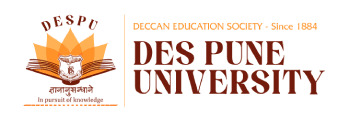
Pune, often dubbed as the "Oxford of the East," has been a pivotal hub for higher education in India. Amidst its educational glory, the Deccan Education Society stands out as a beacon of academic excellence and tradition. Founded with the aim of creating a literate, enlightened society, the Deccan Education Society has etched its name in the annals of educational history. Today, it opens the doors to a plethora of opportunities for aspiring engineers and professionals through its distinguished B.Tech and PG Diploma courses, particularly in the sought-after fields of Computer Science and Electronics & Communication Engineering.
A Legacy of Enlightenment
The Deccan Education Society Pune University is an emblem of educational heritage, reflecting the vision of its founders to impart quality education to all segments of society. This prestigious institution is not just a name but a legacy that has been nurturing minds and fostering innovation for decades. Its commitment to excellence has made it a preferred destination for students aiming to excel in the realms of technology and engineering.
B.Tech Computer Science Colleges in Pune
For tech enthusiasts dreaming of diving into the world of programming, algorithms, and systems, the B Tech in Computer Science colleges in Pune affiliated with the Deccan Education Society offers an unmatched curriculum. These institutions are renowned for their cutting-edge laboratories, experienced faculty, and a dynamic learning environment that encourages practical learning and innovation. Students are prepared to face the global challenges of the IT industry, making these colleges a prime choice for aspiring software engineers and tech professionals.
B.Tech Electronics and Communication Engineering
The field of Electronics and Communication Engineering (ECE) is at the heart of the digital revolution. Btech electronics and communication engineering colleges under the Deccan Education Society provide a comprehensive B.Tech program in ECE designed to meet the ever-evolving demands of the telecommunications, electronics, and information technology sectors. Through a blend of theoretical knowledge and hands-on experience, students gain expertise in designing, analyzing, and implementing electronic systems, opening a pathway to a future filled with promising opportunities in both the public and private sectors.
PG Diploma Courses in Pune
Beyond undergraduate programs, the Deccan Education Society also offers an array of PG Diploma courses in Pune, catering to the need for specialized knowledge and skills in various professional fields. These courses are tailored for graduates seeking to enhance their qualifications, improve job prospects, or shift career paths. With a focus on industry-relevant curricula, these PG Diploma programs ensure that students are well-equipped to tackle the challenges of the professional world.
DES Pune University: A Pinnacle of Academic Excellence
As we delve deeper into the academic opportunities in Pune, it's imperative to highlight the role of DES Pune University in shaping the educational landscape. The Deccan Education Society's affiliation with Pune University marks a collaboration that leverages the best of tradition and modernity, fostering an environment of excellence and innovation. DES Pune University is not just an institution; it is a community of scholars, educators, and students committed to the pursuit of knowledge and the betterment of society.
This partnership enriches the academic offerings, with DES leveraging the resources, research facilities, and academic prowess of Pune University. The synergy between the two institutions amplifies their impact, creating an ecosystem that nurtures critical thinking, creativity, and a passion for lifelong learning. Students of DES have the unique advantage of accessing Pune University's vast library, engaging in interdisciplinary research, and participating in seminars, workshops, and conferences that broaden their academic horizons.
Conclusion
The Deccan Education Society stands as a testament to the power of education in transforming lives and communities. Through its top-tier B.Tech and PG Diploma courses in Pune, the society continues to mold future leaders, innovators, and professionals. Whether it's breaking new ground in Computer Science or pioneering advancements in Electronics and Communication Engineering, the institutions under this venerable society are paving the way for a brighter, more technologically advanced future. Aspiring students and professionals looking to make their mark in the engineering and technology fields will find the Deccan Education Society an exemplary gateway to achieving their dreams.
#b tech in computer science colleges in Pune#B Tech computer science colleges in Pune#Deccan Education Society Pune University#Btech electronics and communication engineering#PG Diploma courses in Pune#DES Pune university
0 notes
Text
youtube
#gate ece#gate ece 2024#gate ece preparation 2024#gate ece video lectures#gate ece cse eee#gate ece 2023 solutions#gate ec cs ee course#gate ece lecture#gate coaching for electronics and communication engineering#gate coaching online#gate classes for electronics computer electrical engineering#gate aptitude#gate aptitude lectures#gate aptitude question and answer#gate aptitude 2024#gate aptitude ece cse eee#gate aptitude previous year solution#gate core ec cs#Youtube
0 notes
Text
youtube
VHDL Basics - Language for Hardware Design : Know why you need to learn VHDL?
What is VHDL? VHDL, short for Very High-Speed Integrated Circuit Hardware Description Language, is a powerful and widely used language for designing digital circuits and systems. If you're interested in digital electronics or pursuing a career in hardware design, learning VHDL is essential. Why Learn VHDL? Understanding VHDL gives you the ability to design and simulate complex digital systems, ranging from simple logic gates to advanced processors. VHDL allows you to describe the behavior and structure of these circuits accurately, enabling efficient development and debugging. By learning VHDL, you gain the skills to create efficient and reliable hardware designs. How to Learn VHDL? Learning VHDL doesn't have to be intimidating! In this tutorial video, we will guide you through the basics of VHDL, explaining the syntax, data types, and essential concepts. We'll also provide practical examples and hands-on exercises to reinforce your understanding. Whether you're a beginner or have some experience with digital design, this video will help you grasp VHDL quickly. Join Our VHDL Community Connect with fellow VHDL enthusiasts and learners in our vibrant community. Share ideas, ask questions, and collaborate with others passionate about hardware design. Our community is a supportive and engaging space to expand your knowledge and stay updated with the latest VHDL developments. Subscribe to Learn and Grow Community for Regular updates. Subscribe to our community for more informative videos and guidance. Stay tuned for tutorials, tips, and tricks to enhance your skills. Hit the notification bell to never miss an update.
Subscribe to "Learn And Grow Community"
YouTube : https://www.youtube.com/@LearnAndGrowCommunity
LinkedIn Group : https://www.linkedin.com/groups/7478922/
Blog : https://LearnAndGrowCommunity.blogspot.com/
Facebook : https://www.facebook.com/JoinLearnAndGrowCommunity/
Twitter Handle : https://twitter.com/LNG_Community
DailyMotion : https://www.dailymotion.com/LearnAndGrowCommunity
Instagram Handle : https://www.instagram.com/LearnAndGrowCommunity/
Follow #LearnAndGrowCommunity
#VHDL#VHDL tutorial#hardware design#digital electronics#VHDL language#VHDL basics#learn VHDL#VHDL syntax#VHDL community#VHDL beginners#digital design#hardware simulation#VHDL examples#VHDL exercises#VHDL processor#VHDL development#Engineering projects#verilog hdl#Free courses#Learn VHDL#Learn Verilog#tutorials#classes#training#career#vlsi industry#job#Youtube
1 note
·
View note
Text
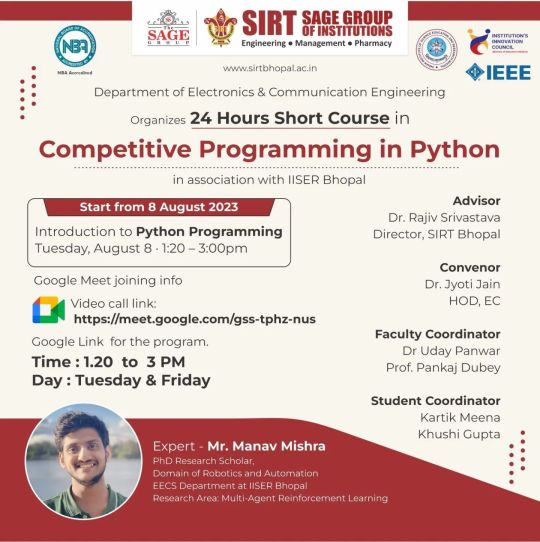
Short Course on Competitive Programming in Python
We are very glad to share that Department of Electronics and Communication Engineering SIRT, Bhopal is organizing a six-week Short Course on "Competitive Programming in Python" in association with IISER Bhopal.
Expert: Mr. Manav Mishra
PhD Research Scholar, Domain of Robotics and Automation
EECS Department at IISER Bhopal
Research Area: Multi-Agent Reinforcement Learning
#python#short term course#Electronics and Communication Engineering#ECE#best engineering college in bhopal#SIRT Bhopal
0 notes
Text
Mtech In Electronics And Communication Engineering In Kolkata
The course has a detailed M tech electronics and communication engineering syllabus that emphasizes a balanced approach between theoretical concepts and practical applications. Students will have access to state-of-the-art laboratories equipped with cutting-edge equipment and software.
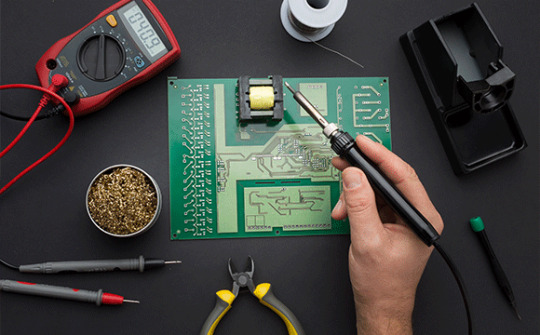
#M tech electronics and communication engineering syllabus#M tech in electronics and communication engineering course
0 notes
Text

Get The Best Diploma in Electronics and Telecommunication Engineering in 2023
Are you looking for the best electronics training courses from the best electronic and telecommunication engineering institute in Kolkata? then visit George Telegraph today and know your course fees details. We provide 100% job placement assistance. Join Now.
#diploma in electronics and telecommunication engineering#electronics and telecommunication engineering#electronics and communication engineering course#george telegraph course#telecommunication courses#electronics training courses#electronics course#electronics courses#courses for electronics engineer#telecommunication engineering courses#electrical and telecommunication engineering#electronics training course#electronic and telecommunication engineering
0 notes
Text
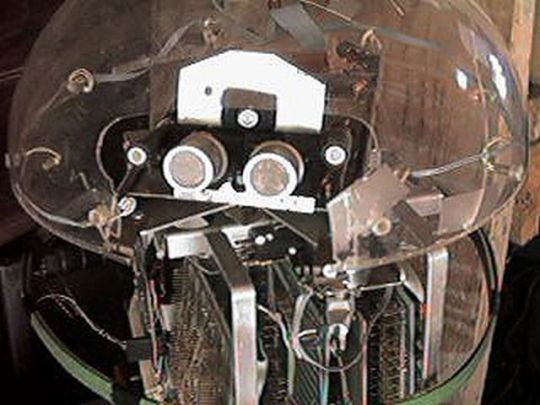
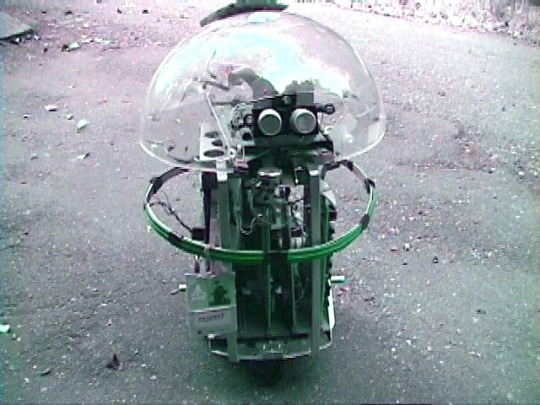
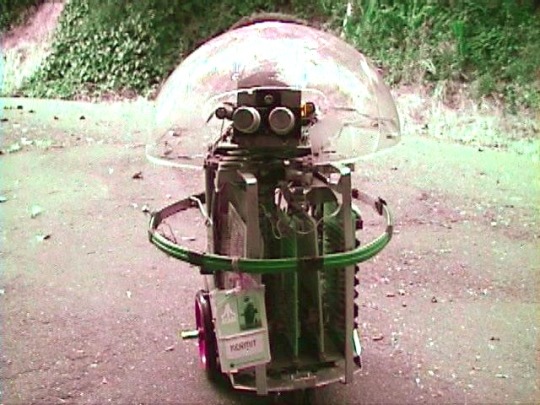
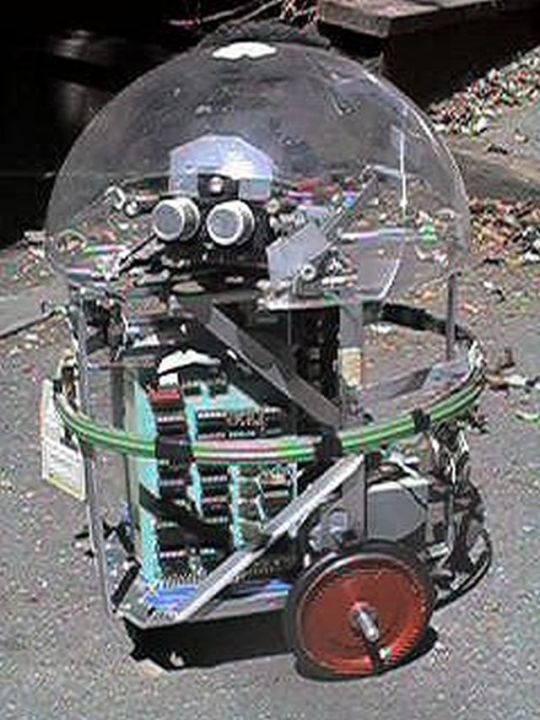

Kermit (1978), by Ron Milner and Larry Nicolson, Cyan Engineering, Atari's secret think tank in Grass Valley, CA.
"The robot was a pet project for Nolan Bushnell, then still the head of Atari and a very creative guy. Its purpose in life was as Nolan put it to "bring me a beer!" Navigation for robots was a sketchy thing at that time with lots of pioneering work at MIT but no consumer cost ideas. Nolan brought us the incredibly original idea to navigate a robot (which mostly meant knowing where it was) by means of scanning bar codes attached here and there to the baseboards in the rooms the robot was to service. Why it wasn't patented I don't know.
I had lots of fun building the R2D2 style robot about 20" tall. I liked to put mechanical and electronic things together and we had a great shop at Cyan. Its brain was one of the 6502 based single board computers-I think it was a KIM but not sure. Locomotion was two DC gear motor driven wheels and an instrumented caster-about the same rig as a modern Roomba. A rotatable turret covered with a plexiglass dome carried microphones, an IR sensor to detect people, and ultrasonic ranging sensors I built on a separate PC board. A speaker so Kermit could beep gleefully, of course.
A ring of contact-detecting burglar alarm sensing tape (green in the pictures) around Kermit's middle told the software he had hit something and should back off. The ultrasonics provided range to obstacles and to some extent direction as the turret was rotated, so we could go around things.
My pride and joy was the barcode remote scanner which was mounted on the bottom of the robot so its rotating head would be level with the barcodes on the baseboards. It had a vertical telescope tube with a beam splitter between the IR Led and the photodiode sensor and a lens to focus 2-20' away. It aimed down at a front surface mirror at 45 degree to scan horizontally. The mirror was mounted on a motor driven turret so it spun around continuously with a sensor once around to resolve the continuous angular position of the beam horizontally of course with respect to Kermit's rotational position. Unfortunately, this part of the robot did not survive the closing of our group. The barcodes I made for the prototype to detect were about 4" tall made of 3/4" reflective 3m tape on black poster board.
My programming partner on the project was Larry Nicholson, a really bright guy. He made the barcode reading work to detect not only the barcodes, but where they were angularly with respect to the robot and also their subtended angle or apparent size (all from timing of the rotation of the scanner) which was a measure of distance combined with angle from the barcode. We worked out some pretty clever math to resolve that information from two or three of the barcodes into a position and orientation of Kermit in the room. We had rented an empty room upstairs on the third floor of the Litton building to try all this out and work out the navigation. Larry and I got the basic navigation and obstacle avoidance working so Kermit could go from one place to a designated other place in the room and avoid wastebaskets placed randomly. We demonstrated it to Nolan and he was impressed.
Shortly thereafter Warner Communication who had bought Atari from Nolan kicked him out and the Kermit project was cancelled."
– Kermit The Robot Notes by Ron Milner.
65 notes
·
View notes
Text
SO-LAR-FUCKING-POWER. Or, as the appearance-obsessed image consultants want us to refer to it now, "photovoltaic energy." Yeah, okay, nerds. A lot of people have been shit-talking solar in the press, because they're afraid that individuals will set up their own power generation facilities in their backyards, roofs, sheds, community centres, what have you, and start pumping out electricity. That will make the big electricity corporations sad, so they've paid all these handsome people to come on the news and yell about it.
Let me put it this way: if there were a magic machine in the sky that shot out a bunch of candy bars every day, like an absolute shitload of Milky Ways, and you were hungry, would you run out into the backyard with a bucket? Or would you feel bad about it because Bob Milky Way, up there in his hateful Cadbury tower, is no longer able to perpetuate his existing business model?
Personally, I've gone big-league on solar, mostly because the utility company disconnected my house after decades of non-payment. Now, I can't afford the new stuff: even the cheap panels that the proud people of China throw onto AliExpress are too costly for my budget. What I've done instead is dig through the landfill (after hours, of course) for several hundred solar desk calculators.
These calculators are electronic devices that we used to use before smartphones in order to compute numbers. And they ran on the sun, because replacing batteries is annoying. After breaking open the calculators, I looped their solar cells together in series, and eventually built a big enough panel to cover my entire roof.
When I say it like that, it sounds easy, and this is the myth of engineering progress: it was actually a lot of stop-and-go stuff, bumps in the road. Rooftop fires. Wiring fires. I fell off the roof a few times. The cops came by at one point and were idling in front of my house, waiting to see if I'd come outside so they could bust me for stealing all those calculators from the dump. In the end, though, I am now able to charge my phone for free, and even run my coffee maker if it's a particularly sunny day. That coffee is the best-tasting coffee I've ever had, because it tastes like billionaire tears.
And I won't stop there, either. Things are going to improve dramatically at the old Switch Family Solar Array as my bougie neighbours throw out their old panels in order to upgrade to the latest and greatest. Pretty soon they'll be paying me to take them – I have it on good authority that the dump charges you like minimum $20 this weekend. If you flip to the last page in my investor deck, you'll notice that I have projected to be able to run my refrigerator by 2025. You better get in on this shit, or we'll bury you with the coal.
304 notes
·
View notes